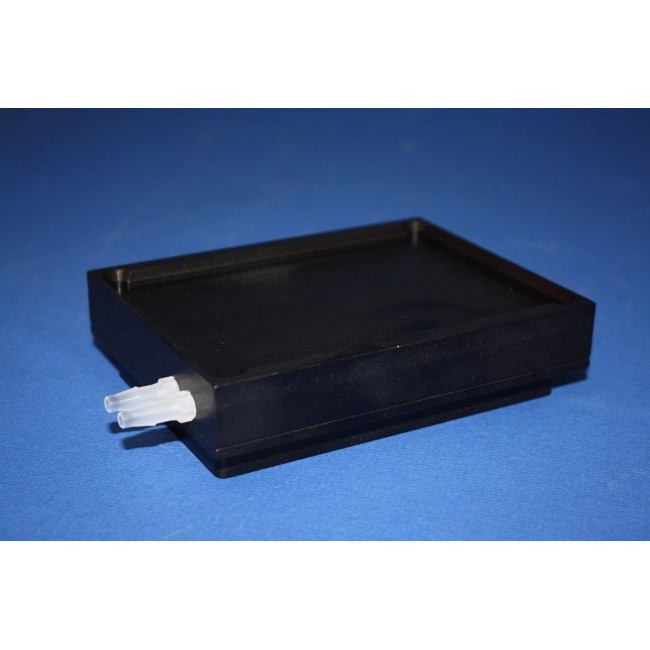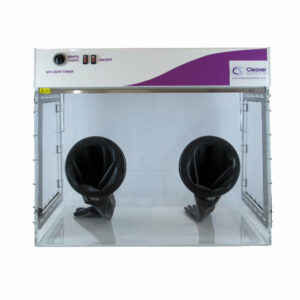V&P Scientific builds robust, low-profile, ambient to 200oC Heating Blocks that enable heating and stirring in standard microplates, deep well microplates or reaction blocks of glass tubes and sealed vials. We construct them out of either graphite or special designed Eddy Current defeating aluminum in a low profile form designed to be used with our strong NdFeB Tumble Stirring machines. Although aluminum is not magnetic, when magnetic lines of flux pass through it, an eddy current of electricity is generated that heats the aluminum and causes the motor that is generating the magnetic feild movement to work much harder. That is why we invented the Eddy Current defeating design for our aluminum Heat Blocks. Their low profile design also minimizes the distance from the samples to the magnetic field thus maximizing the stirring power of even viscous materials. See this Blog for a comparison of graphite and an Aluminum (Eddy Current defeating design) Heat Block.
Each Heating Block comes with one or more SLAS Adaptor Bases made of Mica that is attached to the Heating Block’s underside. This Base provides heat protection for surfaces below the Heating Block and facilitates its use on microplate-configured locations. The Mica is safety rated by UL laboratories as UL 94VO. Another advantage of our designs is that we have separated the control panel from the actual heating block. Thus, facilitating the heat block’s placement on the deck of a robotic workstation.
.
Our Temperature controllers all use an RTD (Resistive Thermal Device) heat sensor. RTD sensors are advantageous because they work in moving magnetic fields generated by V&P Tumble Stirrers while Thermocouples do not work in magnetic fields. This is important when heating and stirring simultaneously.
.
The VP 741ABZ series and VP 743ABZ series Heat Blocks have deep chambers and a lid that can be screwed into place to hold Cap Mats or other sealing materials in place while high temperatures are reached. Heating and simultaneously stirring is very advantageous in redox chemical reactions. Our deep chamber Heating Blocks all come with a U-shaped insert that allows easy removal of standard microplates or other short labware from the Heating Blocks.
The VP 741BZ-R series Heat Blocks were designed to be used on Robotic work stations to process PCR reactions.by having a robot change the reaction temperature by moving the PCR plates between two heat blocks set to different temperatures, one high and one low.
The VP 741G and VP 741GZ series Heat Blocks are made from graphite and designed to fit into a robotic work station and on top of a powerful Tumble Stirrer so 50 ml centrifuge tubes containing bacterial growth media can be stirred and aerated to facilitate microbial growth while the robot is making controlled serial inoculations in Adaptive Laboratory Evolution experiments conducted over long periods of time.
The VP 744 series Heat Blocks are heated or cooled by recirculating hot or cold fluid in the heat exchange channels in the blocks.
The following graph contains data generated in a VP 741ABZ-R-MB Heat Block using a deep well 96 microplate with 2 ml of water in each well. The RTD of the controller is embedded in the aluminum at the base of the Heat Block. The Control temperature was set to 80 deg C and temperature readings were taken in microplate wells located at the middle (C6), side (A6) and corner (A12) positions and plotted against time. As can be seen in the graph the temperature in the wells plateau at 4 to 6 degrees below the set temperature of 80 deg C. This difference between the set temperature and the well temperature needs to be determined and compensated for, in your system using your fluid, your volume, and your microplate or other vessel. This difference in set temperature and well temperature is due to the loss of heat transfer between the aluminum and the microplate and the fluid in the well. Also note the best heat transfer occurs in the wells with greatest contact with the aluminum of the Heat Block, and with time these approach the same temperature. This is why we make Heat Block accessories that maximized the contact between the Heat Block and the microplate or vessel. See this page for Heat Block Accessories.
The applications for Heat Blocks in Chemistry and Biology especially when combined with mixing are almost to many to enumerate. Below we have listed just a few of the applications that our customers have told us about or we have found in the literature.
- Our Tumble Stirrers and Heat Blocks are used in conjunction for a variety of applications such as accelerating chemical, enzymatic and biological reactions in:
- .
- Redox parallel synthesis to develop new drugs Endorsement – see this page
- .
- Photoredox sysmthesis to develop new drugs
- .
- Heating to different temperatures coupled with mixing to determine the solubility of a compound.
- .
- Heating to different temperatures and mixing to determine the optimum temperature for the enzymatic hydrolysis of steryl glucosides
- .
- Heating and stirring chemical reactions to speed completion
- .
- Miniaturization of fermentations & chemical reactions
- .
- Drug Susceptibility Assays
- .
- Resoluabilize dried extracts from large screening libraries
- .
- Protein Expression Screen
- .
- Thorough mixing of heated slurries, viscous solutions and emulsions
- .
- Thorough mixing of heated immiscible liquids
- .
- Resuspend chemical libraries after storage by heating and mixing
- .
- Dissolve solid compounds by heating and mixing
- .
- .
- .
- Bacterial Culture incubation and aeration by mixing for Adaptive Laboratory Evolution experiments
- .
- Heating and Aeration of microbial cultures to increase DNA or protein yield
- .
- Determination of Growth Rate, Metabolite Production, and Final Biomass in a Tumble Stirred and heated Culture Vessel
- .
- .
- See this page for articles referencing applications of our Heat Blocks
Gifs



